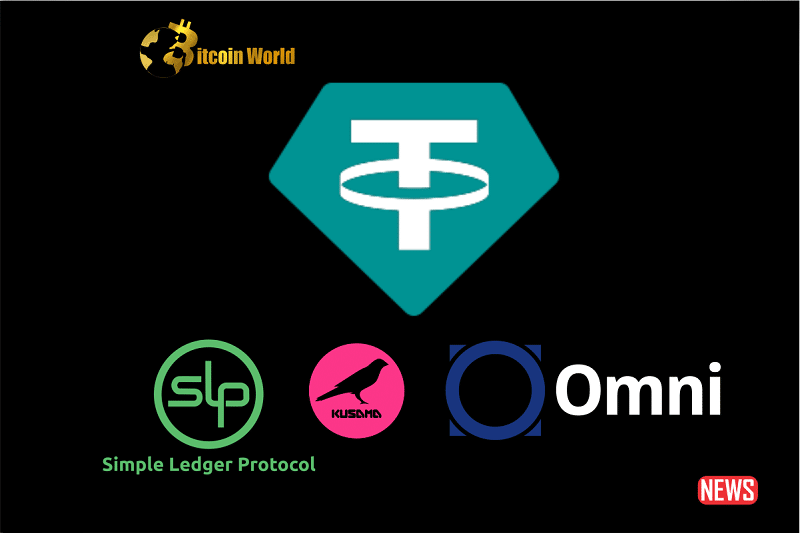In a move that’s rippling through the crypto community, Tether, the issuer of USDT – the world’s leading stablecoin – has announced the end of support for three blockchain networks. Yes, you read that right! Kusama (KSM), Bitcoin Cash’s Simple Ledger Protocol (BCH SLP), and Omni Layer (OMNI) are no longer in Tether’s good graces. But why is this happening, and what does it mean for you, the crypto enthusiast?
Why the Blockchain Breakup? Tether’s Rationale
Tether isn’t just randomly dropping blockchains. They’ve stated that community interest and blockchain health are key factors when deciding where to support USDT. Think of it like choosing which roads to maintain in a city. If a road isn’t used much and is becoming costly to upkeep, it might make sense to focus resources elsewhere. Here’s the official line from Tether:
“We carefully assess the work needed to secure the security, usability, and sustainability of the chosen blockchain, taking into account security, customer support, compliance, and regulatory supervision. Maintaining support becomes ineffective and may risk security and oversight if blockchain experiences sustained traction issues and show no indications of recovery in usage statistics.”
In simpler terms, if a blockchain isn’t seeing enough USDT activity and shows signs of struggling, maintaining support becomes less viable and potentially risky. Let’s break down the blockchains affected:
- Kusama (KSM): Known as Polkadot’s “canary network,” Kusama is designed for experimentation and early-stage deployments. Think of it as a testbed for Polkadot.
- Simple Ledger Protocol (SLP) on Bitcoin Cash (BCH): SLP is a system built on top of Bitcoin Cash that allows for the creation of tokens.
- Omni Layer (OMNI): This is where it gets a bit sentimental. Omni Layer was one of the first protocols built on Bitcoin to enhance its functionality, launching way back in 2013. It was also the very first blockchain Tether used to issue USDT!
Omni Layer: A Fond Farewell?
Paolo Ardoino, Tether’s CTO, didn’t hide the emotional aspect of dropping Omni Layer. He mentioned it was “particularly difficult” due to its historical significance as the original home for USDT. Imagine saying goodbye to your first car – even if you’ve upgraded to a newer model, there’s still a touch of nostalgia.
But sentimentality aside, the numbers speak for themselves. Omni Layer has faced challenges in recent years. Why?
- Limited Token Ecosystem: Unlike some other blockchains, Omni Layer didn’t see a widespread adoption of diverse tokens.
- USDT Availability Elsewhere: As USDT became available on more popular and efficient blockchains, exchanges and users naturally migrated to these alternatives.
This shift led to a decline in USDT usage on Omni Layer, making its continued support less practical.
The Bigger Picture: Staying Agile in the Crypto Space
Tether’s decision, while impacting these specific blockchains, highlights a crucial aspect of the cryptocurrency world: agility and adaptation. The crypto landscape is constantly evolving, with new technologies and trends emerging rapidly. For projects like Tether to remain leaders, they must be willing to make tough calls, even if it means sunsetting support for certain technologies.
As Ardoino stated:
“Even if it means making challenging decisions, as an ethical organization we must maintain consistency, transparency, and adherence to open processes.”
Market Reaction: A Crypto Rollercoaster?
The news of Tether’s decision coincided with some market movements. In the 24 hours following the announcement:
- Bitcoin Cash (BCH) saw a drop of over 14%.
- Kusama (KSM) experienced a decrease of more than 7%.
While correlation isn’t causation, these price movements suggest that the market reacted to the news, possibly reflecting concerns or adjustments related to USDT’s availability on these platforms. It’s a reminder of how interconnected and sensitive the crypto markets can be to even infrastructure-level changes.
Key Takeaways: What Does This Mean for You?
So, what should you take away from this Tether blockchain shakeup?
- Blockchain Ecosystems Evolve: This event underscores the dynamic nature of blockchain technology. Support for different chains isn’t static; it’s based on usage, security, and sustainability.
- Focus on Active Networks: Tether is prioritizing blockchains with strong user activity and growth potential. This suggests a strategic focus on efficiency and scalability.
- Diversification is Key: For users and developers, this is a reminder not to be overly reliant on a single blockchain or protocol. Diversification across multiple networks can mitigate risks associated with changes in support or technology.
- Tether’s Commitment to Security: The decision emphasizes Tether’s commitment to maintaining the security and oversight of USDT. This is crucial for the long-term stability and trust in stablecoins.
Looking Ahead: The Future of USDT and Blockchain Support
Tether’s move is a strategic realignment, focusing resources on blockchains that offer the most utility and growth potential for USDT. While it’s a goodbye to Kusama, BCH SLP, and Omni Layer for USDT minting, it’s likely a strategic step towards a more streamlined and efficient future for the stablecoin giant. As the crypto world continues to mature, we can expect to see more such adaptations and shifts as projects navigate the ever-changing landscape. Stay tuned, crypto enthusiasts, because the journey is far from over!
Disclaimer: The information provided is not trading advice, Bitcoinworld.co.in holds no liability for any investments made based on the information provided on this page. We strongly recommend independent research and/or consultation with a qualified professional before making any investment decisions.


